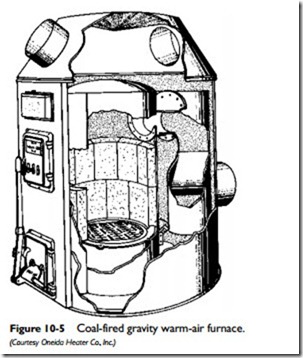Selecting a Furnace for a New House
One of the many decisions involved in building a new house is the se- lection of the heating, ventilating, and air conditioning system. This is probably one of the most important decisions, because the cost of operating and maintaining the system and its efficiency will be a daily fact of life for as long as you live there. It is therefore in your best interest to select the most efficient heating system that you possibly can.
The type of heating system selected (forced-warm-air, hydronic, steam, electric baseboard, etc.) will depend upon such factors as the design of the house, the climate where the house is located, fuel costs, and personal preference. Comments on the advantages and disadvantages of the various types of heating systems are found in Chapters 6 to 9.
Assuming that, like the majority of home owners, you have decided to install a forced-warm-air heating system, you should pay particular attention to selecting a suitable furnace. Should this decision be left entirely to your building contractor? Certainly not. For convenience, friendship, or other reasons, he may prefer to subcontract the work to a heating firm with which he customarily does business. As a result, you may not be getting the best furnace for your needs. For example, John Doe Heating, Ventilating, and Air Conditioning Company may deal in furnace Brand X (or Brands X, Y, and Z). It may be that none of these furnaces is as efficient and economical to operate as the one you might wish to use.
There are many manufacturers of forced-warm-air furnaces doing business in the country. The furnaces produced by these manufacturers differ from one another in a variety of ways, including:
1. Installation cost
2. Design factors
3. Type of fuel used
4. Cost of furnace
5. Furnace gross output (Btu/h)
6. Furnace net output (Btu/h)
7. Furnace efficiency
The installation cost depends upon the area in which you are living and can vary widely for the same furnace model from the same manufacturer. It is not something you can easily control, because it depends upon local labor costs, delivery charges, and availability of equipment.
Design factors involve developments in the heating equipment that improve (or detract from) their performance. For example, some electric-fired furnaces use a direct-drive blower motor instead of a belt-driven one. The direct-drive motor results in a smaller, more compact furnace. The belt-driven blower motor has the advantage of being more easily maintained (it is simply a matter of replacing the standard motor used in the unit). Other design developments include improvement in flame retention (e.g., in oil-fired furnaces), more efficient combustion chambers, or improvements in other components. It may take a little research, but several professional journals in the heating field carry articles reviewing new products. Consumer magazines also provide this service. Do not take the manufacturer’s (or the sales representative’s) claim at face value. Go to your local library and read what the experts have to say.
The type of fuel used will be an important factor in determining future operating costs. What is the cost of the various fuels in your area? Remember, the cheapest may not necessarily be the best for your purposes. Operating costs depend on the total amount of fuel necessary to heat your home on a month-to-month basis. As a gen- eral rule, electricity is more expensive than the fossil fuels, and gas slightly more expensive than oil. Read Chapter 5, “Heating Fuels,” for additional information.
In considering the cost of a furnace, remember that the most expensive furnace is not necessarily the best one, and the cheapest is not always that bargain you expect it to be. Your first consideration should be furnace performance. Although the initial cost of a suit- able furnace may be high relative to others, it will soon pay for itself with lower operating costs.
Furnace efficiency is expressed as a percentage and is found by subtracting furnace net output (the actual amount of heat delivered to the rooms) from furnace gross output. For example, an oil-fired furnace with a gross output of 150,000 Btu/h and a net output of 120,000 Btu/h will have an approximate efficiency of 80 percent.
By way of review, the three basic steps involved in selecting a suitable furnace for a new house are as follows:
1. Determine the type of heating system you want for the house.
2. Estimate the amount of heat loss from the structure; see Chapter 4, “Sizing Residential Heating and Air Conditioning Systems.”
3. Select a furnace with a heating capacity capable of replacing the lost heat.
